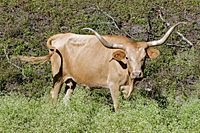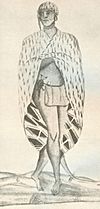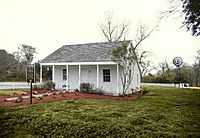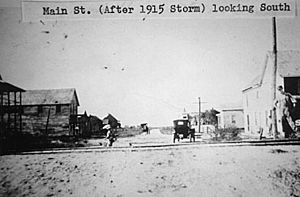History of the Galveston Bay Area facts for kids
For over 7,000 years, people have lived in the Galveston Bay Area in what is now the United States. The communities here have been shaped by the important cities of Houston and Galveston. Even though they were never one single community, the towns around Galveston Bay share a lot of history.
Before Europeans arrived, the area was home to the Karankawa and Atakapan tribes. These groups lived along the Gulf Coast. Spanish and French explorers visited the area for many years. They slowly started trading with the local Native Americans. In the early 1800s, the famous pirate Jean Lafitte built a small, short-lived base on Galveston Island. He was later forced out by the United States Navy.
After Mexico became independent from Spain, new settlements were built around the bay. These included Anahuac and San Jacinto. Early fights by settlers against Mexican rule happened here. The area was also where the Texas army won against the Mexican army during the Texas Revolution. After Texas became independent and then joined the United States, the economy first grew with farming and cattle ranching. Trade increased between Galveston, Harrisburg, and Houston in the late 1800s. This created more jobs as railroads were built through the Bay Area.
In the early 1900s, some of Texas's first oil fields and refineries appeared here. This was part of the Texas Oil Boom. Factories and refining grew quickly, especially around Baytown, Pasadena, and Texas City. The opening of the Port of Texas City, and later Barbours Cut and Bayport, made the region an important shipping center. As people in southeast Texas became wealthier, resorts and tourist spots also grew in the Bay Area. In the 1960s, the area became home to the Johnson Space Center. This was the main place for the nation's human space program. It helped the economy grow in new ways, bringing in aerospace and high-tech industries.
Contents
Early Bay Area History
The land along the Gulf Coast was shaped about 30,000 years ago during an ice age. The sea level dropped a lot then. When the ice melted later, water flowed through the Trinity and San Jacinto rivers. This carved out wide valleys in the soft ground. This created the bays and lakes we see today, about 4,500 years ago.
Humans first came to this region as early as 10,000 years ago. They followed migrations from Asia during the ice age. Studies show that the first settlements around Galveston Bay might have been built around 5500 BCE. The first clay pots appeared around 100 CE, and arrow points around 650 CE. When Europeans first arrived, many Native Americans still lived here.
The Capoque tribe, a part of the Karankawa people, lived along the southern coast. This was near the Colorado River and Matagorda Bay, stretching up toward Galveston Bay. The Akokisa, or Han, tribe lived in the northeast. They were part of the Atakapan people.
The Karankawa were hunter-gatherers who moved from place to place. They ate deer, bison, peccary, and bears. They also ate fish, oysters, nuts, and berries when they were available. They used portable huts for shelter. They traveled the many waterways and the coast in dugout canoes. This gave them an advantage over the Europeans at first. The Akokisa in the area also hunted and gathered. They used canoes for travel. They were known for their skill in tanning animal hides, especially bear hides. In the 1700s, about 3,500 Akokisa people lived in the area.
Spanish explorer Álvar Núñez Cabeza de Vaca and his crew were shipwrecked here in 1528. They were the first known Europeans to land in the area, though it's not clear exactly where. Cabeza de Vaca and the other survivors left as soon as they could, traveling to safety in Mexico.

The Rivas-Iriarte expedition, a Spanish sea journey, explored Galveston Bay in detail in 1687. This was likely the first scientific exploration. In 1785, another expedition by José Antonio de Evia named the bay and island Galveztown or Galvezton. This was in honor of the Spanish Viceroy Bernardo de Gálvez.
In the early 1700s, French traders began trading furs with the Akokisa and Bidai tribes. In 1754, traders set up a trading post on the Trinity River, north of the bay, near modern Wallisville. Spanish officials quickly took over the post and made it into the San Augustín de Ahumada fort. They called the place El Orcoquisac and built a Catholic mission. The Spanish could not keep up trade with the Native Americans, and the post was abandoned within a few years.
More Spanish and U.S. settlers moved into the area. By the end of the century, Native American populations had dropped sharply. This was due to diseases and losing their land to Europeans.
In 1816, the pirate Louis-Michel Aury claimed Galveston Island as a base. He used it to support Mexico's fight against Spain. Aury was later replaced by Jean Lafitte. Lafitte was a famous Louisiana pirate and an American hero from the War of 1812. Lafitte worked as a privateer for the Spanish Empire. He turned Galveston Island and the bay into a pirate kingdom called Campeche. He set up bases for illegal trade and ship repair on the Trinity River and at Eagle Point (modern San Leon). His group also had a hideout on the shores of Clear Lake. As late as 1965, treasure from this time was found at Kemah. The United States Navy forced Lafitte off the island in 1821, and the colony was abandoned. Some settlers, like Anson Taylor, who supplied food from the Clear Lake area to Campeche, stayed behind.
Mexican Rule and Texas Independence
In the early 1800s, after the Louisiana Purchase, Texas became a point of disagreement between Spain and the United States. Groups from the U.S. tried to take control of parts of Texas, but failed. This led to some temporary settlements near the bay, like Perry's Point near modern Anahuac. Spanish officials began to settle Texas to protect their claim. To encourage settlement, the Spanish government gave land to pioneers from the United States, including Moses Austin.
Soon after, Mexico declared its independence from Spain. It then took control of Texas. Mexican officials found it hard to get Mexican settlers to move to the coastal areas. This was because they feared the local tribes. So, they continued to allow settlers from the United States into the area, as long as they promised loyalty to Mexico. Austin's son, Stephen F. Austin, started a colony that reached from central Texas to Galveston Bay and the Gulf Coast. Some of Austin's first Old 300 settlers, like John Dickson, William Scott, and John Iiams, built homes and businesses around the bay.
The Port of Galveston and a permanent settlement were built on the island in 1825 to boost trade. Communities like Lynchburg, San Jacinto, and Campbell's Bayou (started by one of Lafitte's former officers) slowly grew around the bay. Besides Anglo-American and Mexican settlers, a Cajun settlement was built along Armand Bayou.
The Mexican Colonization Law of 1824 tried to stop settlements near the coast. This was meant to protect the Native American tribes. But the law was not enforced, and settlers kept moving onto tribal lands. Native tribes stayed in the area for years but were slowly pushed out as European settlers moved in. The Akokisa were driven inland and joined with the Bidai. The Karankawa were pushed south, eventually settling in northeastern Mexico.
The Galveston Bay and Texas Land Company was formed in New York in 1830. Its goal was to encourage more settlement around Galveston Bay and other parts of southeast Texas. The company brought many colonists from the United States and Europe. However, conflicts with Mexican officials over colonization laws made this difficult at first.
In 1830, Mexican authorities set up a customs and military post near the bay. It was led by Juan Davis Bradburn. This post, which later became the city of Anahuac, was the first major outpost on the mainland shores. It temporarily replaced Galveston as a port of entry. New Washington (modern Morgan's Point) and Austinia (within modern Texas City) were also founded by settlers from the company.
Conflicts between Bradburn and the settlers grew. They argued over land rights, slavery laws, and customs duties. These arguments led to the Anahuac Disturbances. This was a preview of the bigger Texas rebellion. As a result, Mexican authorities were forced out of eastern Texas, and the settlers began to talk about independence.
After a change in the Mexican government, Antonio Lopez de Santa Anna became president. He took away many freedoms Texans had enjoyed. This made relations with the settlers even worse. Texas declared its independence and revolted in 1835. After several battles, the Texas army, led by General Sam Houston, finally defeated Santa Anna in the Battle of San Jacinto, near modern Pasadena.
The new Republic of Texas grew quickly. The shores of the bay were first home to farms and ranches. Longhorn cattle, which roamed wild in Texas, became a free resource. Their hides and beef were shipped across North America. The famous Allen Ranch was built near Harrisburg, in what is now southeast Houston and Pasadena. Other ranches, like Bay Lake Ranch, also grew around the bay. The land for these ranches covered most of the area south of the San Jacinto River.
Cedar Bayou (part of modern Baytown), Shoal Point (part of modern Texas City), and other small communities began to grow. Eagle Point (part of modern San Leon) became an important trading post, including for the trade of enslaved people.
Inland from the bay, Harrisburg and Houston were founded on the Buffalo Bayou. These towns, started by business owners from New York, competed as trade centers. But neither was as important as Galveston. Throughout the 1800s, these three cities had more and more influence on the Bay Area communities. This was especially true as railroads were built through the region.
Several hurricanes hit the region during this time and later. None in the 1800s were truly disastrous, but they still caused a lot of damage and some deaths.
Joining the United States

Texas successfully joined the United States in 1845. This was one of the main reasons for the Mexican–American War. Texas joining the U.S. brought more people to the state. Ranching grew around the bay, along with farming and lumber businesses. The building of the Galveston, Houston and Henderson (GH&H) Railroad, which started in 1857, helped the region grow even more.
During the American Civil War, when Texas left the United States, the area played a small role. No major battles were fought on the mainland shoreline. New forts, like Fort Chambers near Anahuac, were built. These were meant to stop Union forces from invading the mainland and to protect supply routes to and from Galveston. The GH&H Railroad was used when Confederate forces took back Galveston in 1863. Temporary hospitals, like the Nolan home in Dickinson, were set up in the bayside communities.
After the war, the Texas economy declined for a while. However, ranching became a major economic driver. It led to many other businesses, like hide processing plants and shipping companies. Some formerly enslaved people were able to benefit from ranching's economic influence. Successful African American communities were established, including "the Settlement" in what is now League City.
The success of businesses in the area and Galveston's growth as a major trade center helped build the Gulf, Colorado and Santa Fe Railway. The La Porte, Houston and Northern Railroad was also built during the 1800s. These railroads built lines near the southwest shore of the bay. This led to the creation of La Porte, Clear Creek (modern League City), Webster, Edward's Point/North Galveston (modern San Leon), and others (including Texas City later).
Toward the end of the century, ranching became less profitable. Many communities then focused more on farming. The farming community of Pasadena was established during this time. By the end of the 1800s, the land south of Buffalo Bayou was known as the "Texas Fruit Belt." This was because of the oranges, pears, grapes, and other fruits and vegetables grown there.
Sylvan Beach park was created at La Porte. It was a beachfront summer getaway from Houston. With bathhouses, boating piers, and a Victorian hotel with a dance hall, Sylvan Beach quickly became the most popular tourist spot in the Houston area.
In 1900, a huge hurricane hit Galveston. It caused massive damage to the city and heavily damaged communities around the bay. Some estimates say over a thousand people died on the coast outside of Galveston. Bridges between Galveston and the mainland were destroyed. Communities along the shoreline struggled for some time. Economic growth moved inland, and Houston became the main economic center in Southeast Texas. The region's population grew as some Galveston survivors moved to the mainland after the disaster.
Wars and the Oil Boom
The quiet communities around the bay changed a lot in the 1900s. After the terrible 1900 hurricane, the new Red Cross gave donations. This included millions of strawberry plants to Gulf Coast farmers. This helped communities recover. Later, Texaco founder Joseph S. Cullinan started a large strawberry farm here. This made Pasadena an important fruit producer for many years.
The new community of Texas City opened its port and railroad connections. It shipped cotton and grain. Because the port opened just before the 1900 hurricane, it could handle Galveston's diverted shipping traffic until Galveston's port was fixed. After another hurricane in 1915, the Texas City Dike was built. This protected the Texas City ship channel from moving sand during future storms. It helped people trust the port's safety. However, one immediate effect of the dike was that it increased salt levels in West Bay, between Galveston and the southwest coast.
Large parts of the Allen Ranch were sold off. This opened up new development around Pasadena and other bayside communities. Commercial fishing for oysters and shrimp grew into a major industry. The lumber industry also continued to expand. A sugar refinery opened in Texas City, a paper mill in Pasadena, and other factories in the early 1900s.
After oil was found at Spindletop (about 40 miles (64 km) from Galveston Bay) in 1901, Texas entered a time of economic growth called the Texas Oil Boom. Oil exploration at Galveston Bay began soon after. The Goose Creek Oil Field was discovered in 1903. The first well at Goose Creek was built in 1907, with a lot of oil production starting in 1908. By 1924, it was the state's third largest oil field. In 1915, the first offshore oil drilling site in Texas opened at Goose Creek. Other oil fields were gradually found around the bay, including the Anahuac oil field in 1935.
The first refinery by the bay was built in 1908 at Texas City. Refineries then followed in Baytown and Pasadena. The main refinery in Baytown, built by Humble Oil (now ExxonMobil), became the largest in the state.

The wealth from the oil boom changed the region. The population grew quickly due to many people moving in from other parts of the United States, from Mexico, and from overseas. Mexicans, escaping the Mexican Revolution in 1910, added a lot to the population of what is now Baytown. Sicilian immigrants greatly increased the community of Dickinson. Japanese rice farmers settled in Webster, Pasadena, and League City. In fact, the rice industry on the U.S. Gulf Coast started in Webster, thanks to Seito Saibara.
Major manufacturing centers grew throughout the Bay Area. Houston became the main business and financial center for the boom. Wealthy Houstonians built waterfront getaways in Morgan's Point and a boardwalk amusement park at Sylvan Beach, La Porte. These areas were known as the Texas "Gold Coast." Summer homes were also built in Seabrook and other communities.
During Prohibition, Galveston Bay became an important entry point for illegal trade. This trade supplied most of Texas and much of the Midwest. Boats arrived at places from Galveston to Seabrook. Groups involved in illegal activities, which operated in Galveston at that time, created casino areas in Kemah and Dickinson and other parts of Galveston County. Houstonians often jokingly called the county line the "Maceo-Dickinson line" (a play on the Mason-Dixon line). Much of the area around Clear Lake was developed as vacation properties for the wealthy. This included a large ranch owned by Houston businessman James West. Even though the Great Depression closed many businesses, oil-related growth helped lessen its effects.
During the World Wars, factories around the bay were used to mass-produce many products. These included aviation fuel, synthetic rubber, and ships. The first tin smelter outside of Europe opened in Texas City. It became one of the world's main suppliers. The population in the Bay Area grew even faster than Houston. This was because processing plants and factories were built and expanded. Ellington Air Force Base was built southeast of Houston (next to modern Clear Lake City). It became a major air field and flight training center during the wars.
Industrial growth and city development in the early 1900s led to pollution in the bay. By the 1970s, some sources called the bay "the most polluted body of water in the U.S." The ship channel and Clear Lake were said to have even worse water quality. Drilling for oil and underground water, along with large waves from more shipping, caused the land to sink and the shoreline to erode. This was especially true in the Baytown-Pasadena area. Today, about 100 acres (0.40 km2) of the historic San Jacinto battleground are underwater. Most of Sylvan Beach is gone, and the once well-known Brownwood neighborhood of Baytown had to be abandoned.
In 1947, an explosion on a ship at the Port of Texas City caused fires and destruction throughout the city's industrial area and on other ships. This was one of the nation's worst industrial accidents. The tragedy caused over 500 deaths, more than 4,000 injuries, and over $50 million in damage (which would be much more today). Although the city's growth was interrupted, the city and business leaders were able to rebuild.
Modern Times
The war effort had brought many different types of industries to the area. This variety helped the area switch to a peacetime economy, though the oil industry became a major focus again. In 1952, the Gulf Freeway, then part of U.S. Route 75, was finished. It provided a fast car link between Houston and Galveston. This new freeway, considered amazing at the time, greatly encouraged new development in the western part of the bay.
Hurricane Carla, Texas's largest recorded storm, hit the coast in 1961. It caused a lot of flooding and damage in Texas City and other communities. Few lives were lost because people were evacuated. As a result, the flood control dike was expanded, and construction on the Texas City seawall began. This project was finished in 1985.
NASA's Johnson Space Center (JSC) was built in the area in 1963. This, along with Houston's huge growth in the mid-1900s (especially the 1970s and 1980s), caused the rest of the communities on the southwestern shore to become more urbanized. The Clear Lake City community was created by the Friendswood Development Company, a project of Humble Oil and Dell E. Webb Corporation. It was built to support housing growth near the new NASA facility. The communities around Clear Lake quickly focused on aerospace industries, and the region's economy became more diverse. City development spread steadily between Houston and the Bay Area communities. Houston officially took over most of Clear Lake City in 1977, with Pasadena taking most of the rest. However, most other communities around the bay had already formed their own towns, or did so soon after, and so remained independent of the larger city.
The economic boom of the 1970s and early 1980s in Texas (due to the rise in oil prices) greatly helped the Bay Area communities. Industrial operations expanded. This included the opening of the U.S. Steel plant in Baytown in 1970, and the Barbours Cut shipping terminal at Morgan's Point in 1977. The Port of Texas City became the third leading port in Texas by weight of goods, and ninth in the nation. The Barbours Cut terminal, run by the Port of Houston, became the seventh leading port in the nation.
Not all of this development was without problems. To build Barbours Cut, the Port of Houston used its power of eminent domain to force residents out of nearly one third of the homes in Morgan's Point. Still, when the Texas economy slowed down in the late 1980s, the area's economic diversity and large yearly federal investments related to JSC helped the region do better than most of Greater Houston.
Efforts to protect the environment in the mid to late 1900s by local industries and towns greatly improved water quality in the bay. The Nature Conservancy and Houston's Outdoor Nature Club (ONC) helped encourage nature preservation. This included creating the Anahuac National Wildlife Refuge, the Armand Bayou Nature Center, and the Texas City Prairie Preserve. Tourism in the area grew, especially around Clear Lake, largely led by the Space Center. Some former resort communities from the early 1900s, like Kemah and Seabrook, became popular again. Clear Lake itself now has one of the largest groups of marinas in the world.
In the late 1900s and beyond, many communities and businesses in the area began working together. This included the Clear Lake Area Chamber of Commerce, the Bay Area Houston Economic Partnership, and the Bay Area Houston Transportation Partnership. Their goal was to create a clear economic and civic identity for the region and to plan for regional development. Most communities in the region have become official towns. However, a few unincorporated communities remain under the extra-territorial jurisdiction of nearby towns. These include San Leon, Bacliff, and Smith Point. San Leon and Bacliff, despite being by the sea and near the successful Clear Lake Area, and having summer resorts in the early 1900s, have faced economic decline since the mid-1900s. They are now among the less wealthy parts of the Bay Area.
In 2008, Hurricane Ike hit the coast. It caused a lot of damage to both the environment and the economy. As of 2009, the region's environment is still recovering. Damage from both natural pollution (sea salt) and human-made pollution (chemicals washed into freshwater and the bay) still shows big effects on marine and land animals. Commercial fishing and oyster farming are expected to take decades to fully recover. Most major industries were able to return to normal operations, but some tourist areas have taken longer to recover.
Discussions about building an Ike Dike began in 2009. This dike would protect the Bay Area, especially the very important Houston Ship Channel. As of 2010, the project is still in the planning stage.






